ACCT20075 Auditing and Ethics Report: Ramsay Healthcare Case Study
VerifiedAdded on 2023/03/17
|16
|2966
|88
Report
AI Summary
This report provides a comprehensive analysis of the audit procedures, materiality, and financial analysis for Ramsay Healthcare Limited. The report begins by establishing planning materiality and discussing its significance, followed by an examination of key audit matters such as goodwill valuation and impairment of assets. Ratio analysis is used to identify trends in liquidity, profitability, efficiency, and solvency, and it helps to highlight key risk areas that need to be addressed during the audit. The report delves into specific audit procedures for addressing risks associated with employee benefits, cash and cash equivalents, and profitability. Furthermore, the report analyzes the company's cash flow activities, evaluating the going concern concept, and it concludes with a brief overview of the audit opinion. The report is based on the annual reports and relevant information of Ramsay Healthcare Limited.
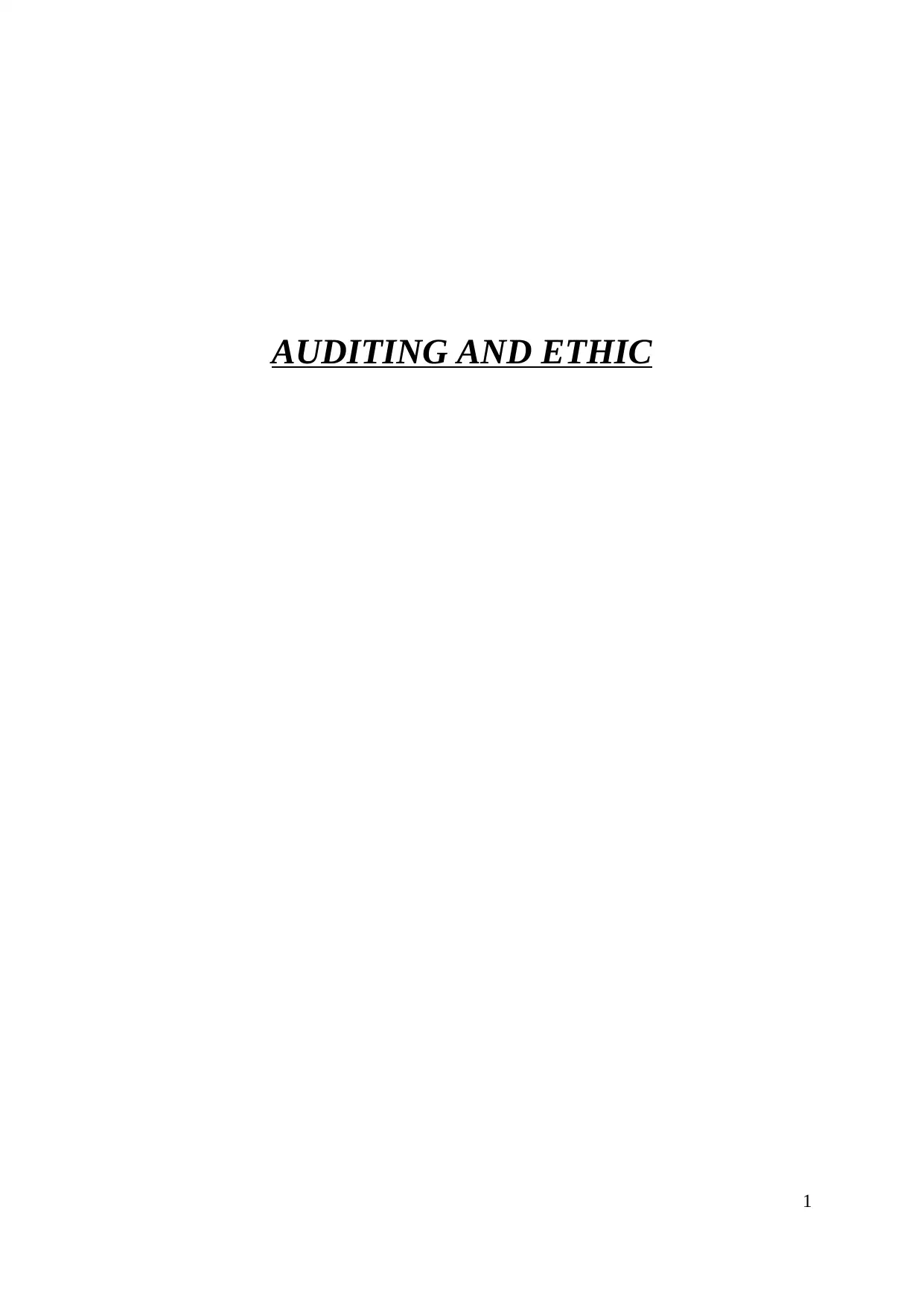
AUDITING AND ETHIC
1
1
Paraphrase This Document
Need a fresh take? Get an instant paraphrase of this document with our AI Paraphraser
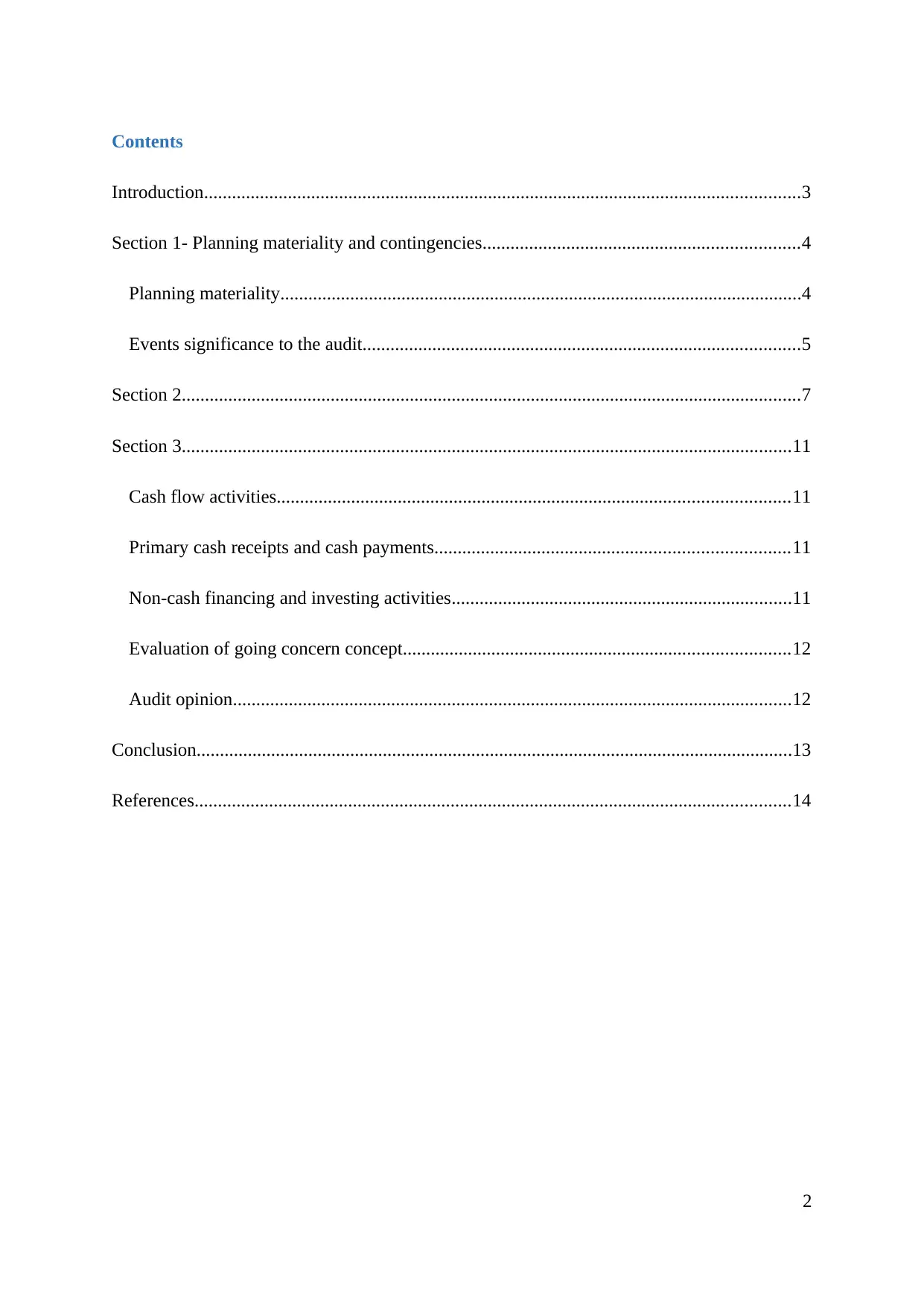
Contents
Introduction................................................................................................................................3
Section 1- Planning materiality and contingencies....................................................................4
Planning materiality................................................................................................................4
Events significance to the audit..............................................................................................5
Section 2.....................................................................................................................................7
Section 3...................................................................................................................................11
Cash flow activities..............................................................................................................11
Primary cash receipts and cash payments............................................................................11
Non-cash financing and investing activities.........................................................................11
Evaluation of going concern concept...................................................................................12
Audit opinion........................................................................................................................12
Conclusion................................................................................................................................13
References................................................................................................................................14
2
Introduction................................................................................................................................3
Section 1- Planning materiality and contingencies....................................................................4
Planning materiality................................................................................................................4
Events significance to the audit..............................................................................................5
Section 2.....................................................................................................................................7
Section 3...................................................................................................................................11
Cash flow activities..............................................................................................................11
Primary cash receipts and cash payments............................................................................11
Non-cash financing and investing activities.........................................................................11
Evaluation of going concern concept...................................................................................12
Audit opinion........................................................................................................................12
Conclusion................................................................................................................................13
References................................................................................................................................14
2
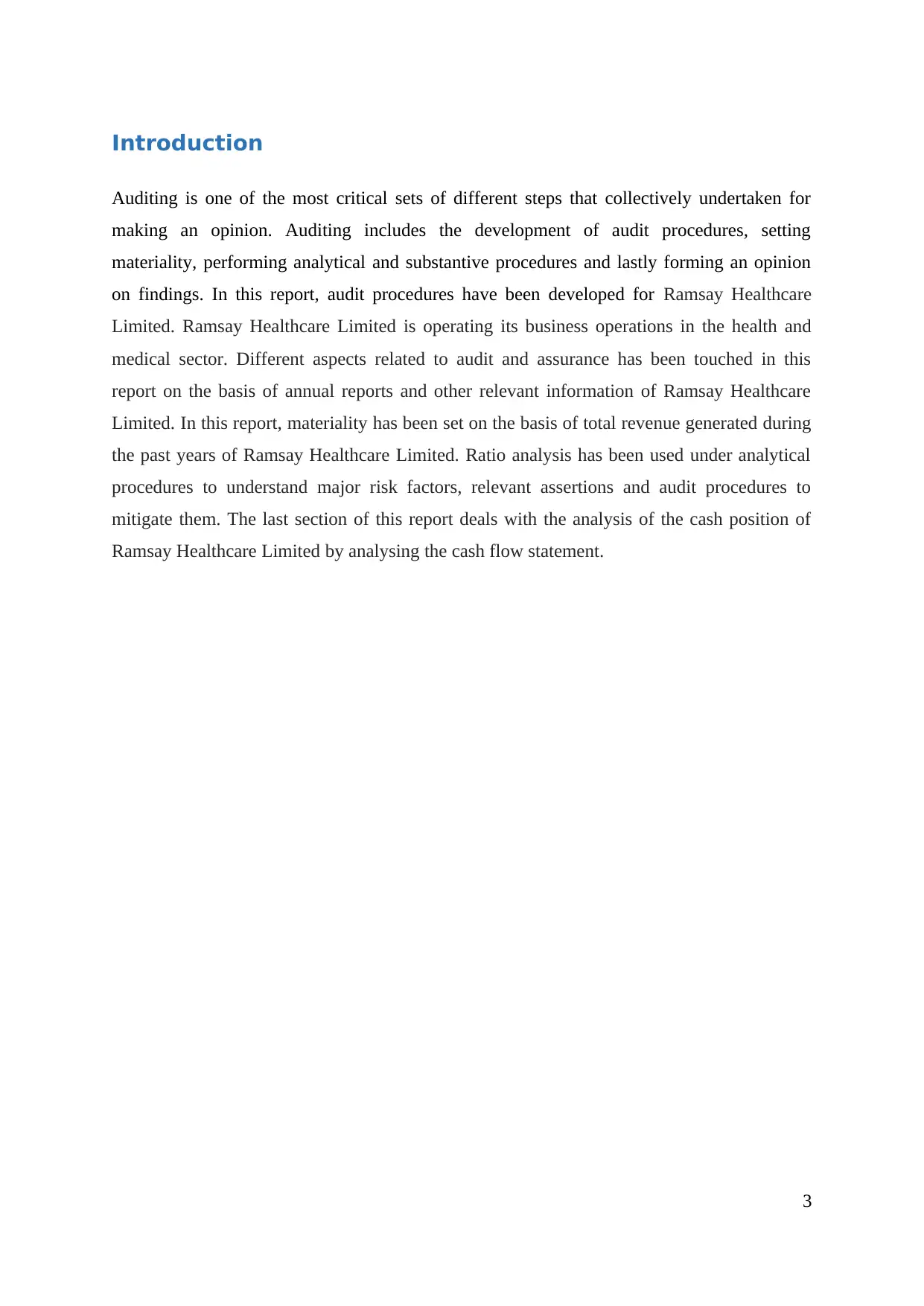
Introduction
Auditing is one of the most critical sets of different steps that collectively undertaken for
making an opinion. Auditing includes the development of audit procedures, setting
materiality, performing analytical and substantive procedures and lastly forming an opinion
on findings. In this report, audit procedures have been developed for Ramsay Healthcare
Limited. Ramsay Healthcare Limited is operating its business operations in the health and
medical sector. Different aspects related to audit and assurance has been touched in this
report on the basis of annual reports and other relevant information of Ramsay Healthcare
Limited. In this report, materiality has been set on the basis of total revenue generated during
the past years of Ramsay Healthcare Limited. Ratio analysis has been used under analytical
procedures to understand major risk factors, relevant assertions and audit procedures to
mitigate them. The last section of this report deals with the analysis of the cash position of
Ramsay Healthcare Limited by analysing the cash flow statement.
3
Auditing is one of the most critical sets of different steps that collectively undertaken for
making an opinion. Auditing includes the development of audit procedures, setting
materiality, performing analytical and substantive procedures and lastly forming an opinion
on findings. In this report, audit procedures have been developed for Ramsay Healthcare
Limited. Ramsay Healthcare Limited is operating its business operations in the health and
medical sector. Different aspects related to audit and assurance has been touched in this
report on the basis of annual reports and other relevant information of Ramsay Healthcare
Limited. In this report, materiality has been set on the basis of total revenue generated during
the past years of Ramsay Healthcare Limited. Ratio analysis has been used under analytical
procedures to understand major risk factors, relevant assertions and audit procedures to
mitigate them. The last section of this report deals with the analysis of the cash position of
Ramsay Healthcare Limited by analysing the cash flow statement.
3
⊘ This is a preview!⊘
Do you want full access?
Subscribe today to unlock all pages.

Trusted by 1+ million students worldwide
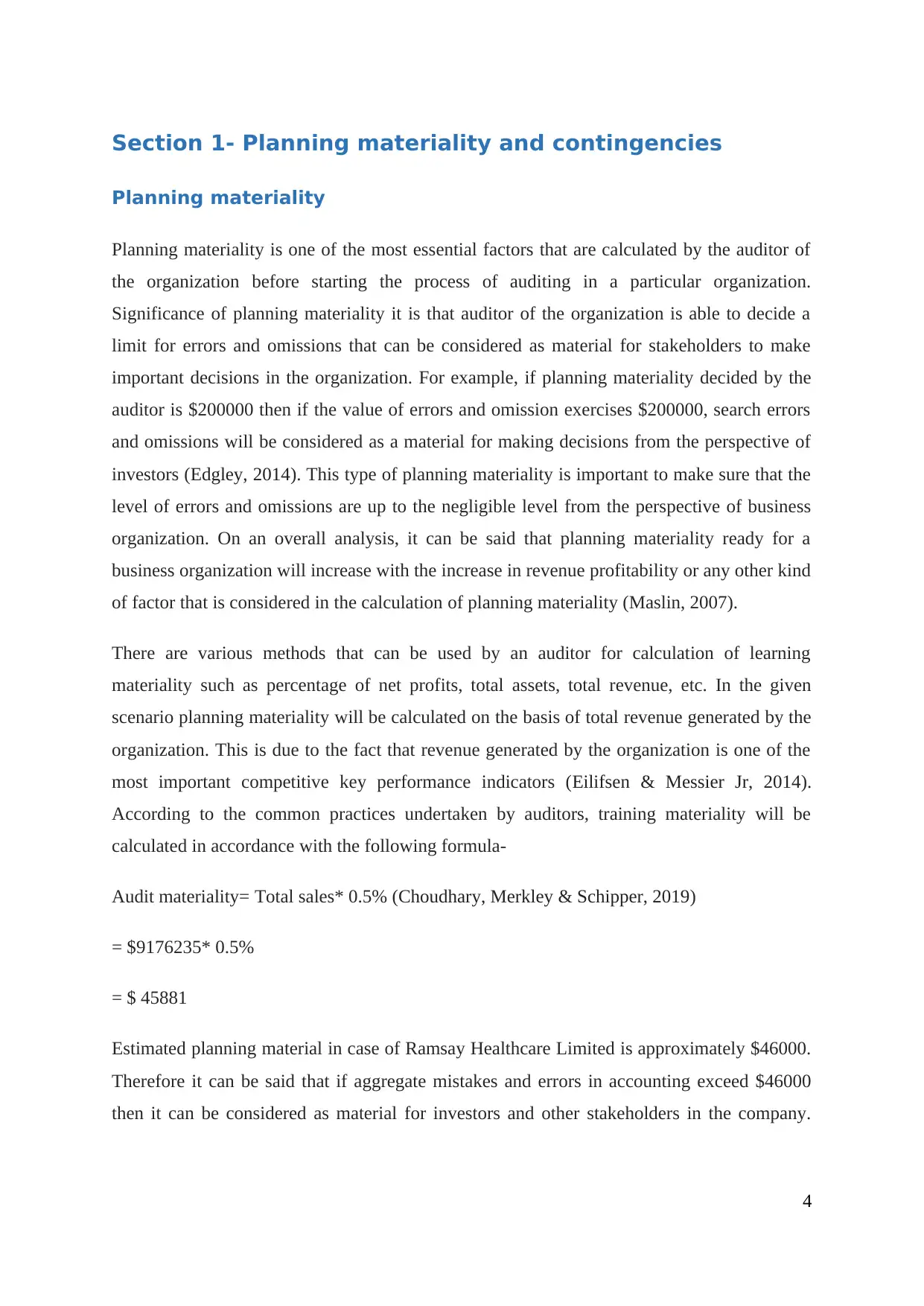
Section 1- Planning materiality and contingencies
Planning materiality
Planning materiality is one of the most essential factors that are calculated by the auditor of
the organization before starting the process of auditing in a particular organization.
Significance of planning materiality it is that auditor of the organization is able to decide a
limit for errors and omissions that can be considered as material for stakeholders to make
important decisions in the organization. For example, if planning materiality decided by the
auditor is $200000 then if the value of errors and omission exercises $200000, search errors
and omissions will be considered as a material for making decisions from the perspective of
investors (Edgley, 2014). This type of planning materiality is important to make sure that the
level of errors and omissions are up to the negligible level from the perspective of business
organization. On an overall analysis, it can be said that planning materiality ready for a
business organization will increase with the increase in revenue profitability or any other kind
of factor that is considered in the calculation of planning materiality (Maslin, 2007).
There are various methods that can be used by an auditor for calculation of learning
materiality such as percentage of net profits, total assets, total revenue, etc. In the given
scenario planning materiality will be calculated on the basis of total revenue generated by the
organization. This is due to the fact that revenue generated by the organization is one of the
most important competitive key performance indicators (Eilifsen & Messier Jr, 2014).
According to the common practices undertaken by auditors, training materiality will be
calculated in accordance with the following formula-
Audit materiality= Total sales* 0.5% (Choudhary, Merkley & Schipper, 2019)
= $9176235* 0.5%
= $ 45881
Estimated planning material in case of Ramsay Healthcare Limited is approximately $46000.
Therefore it can be said that if aggregate mistakes and errors in accounting exceed $46000
then it can be considered as material for investors and other stakeholders in the company.
4
Planning materiality
Planning materiality is one of the most essential factors that are calculated by the auditor of
the organization before starting the process of auditing in a particular organization.
Significance of planning materiality it is that auditor of the organization is able to decide a
limit for errors and omissions that can be considered as material for stakeholders to make
important decisions in the organization. For example, if planning materiality decided by the
auditor is $200000 then if the value of errors and omission exercises $200000, search errors
and omissions will be considered as a material for making decisions from the perspective of
investors (Edgley, 2014). This type of planning materiality is important to make sure that the
level of errors and omissions are up to the negligible level from the perspective of business
organization. On an overall analysis, it can be said that planning materiality ready for a
business organization will increase with the increase in revenue profitability or any other kind
of factor that is considered in the calculation of planning materiality (Maslin, 2007).
There are various methods that can be used by an auditor for calculation of learning
materiality such as percentage of net profits, total assets, total revenue, etc. In the given
scenario planning materiality will be calculated on the basis of total revenue generated by the
organization. This is due to the fact that revenue generated by the organization is one of the
most important competitive key performance indicators (Eilifsen & Messier Jr, 2014).
According to the common practices undertaken by auditors, training materiality will be
calculated in accordance with the following formula-
Audit materiality= Total sales* 0.5% (Choudhary, Merkley & Schipper, 2019)
= $9176235* 0.5%
= $ 45881
Estimated planning material in case of Ramsay Healthcare Limited is approximately $46000.
Therefore it can be said that if aggregate mistakes and errors in accounting exceed $46000
then it can be considered as material for investors and other stakeholders in the company.
4
Paraphrase This Document
Need a fresh take? Get an instant paraphrase of this document with our AI Paraphraser
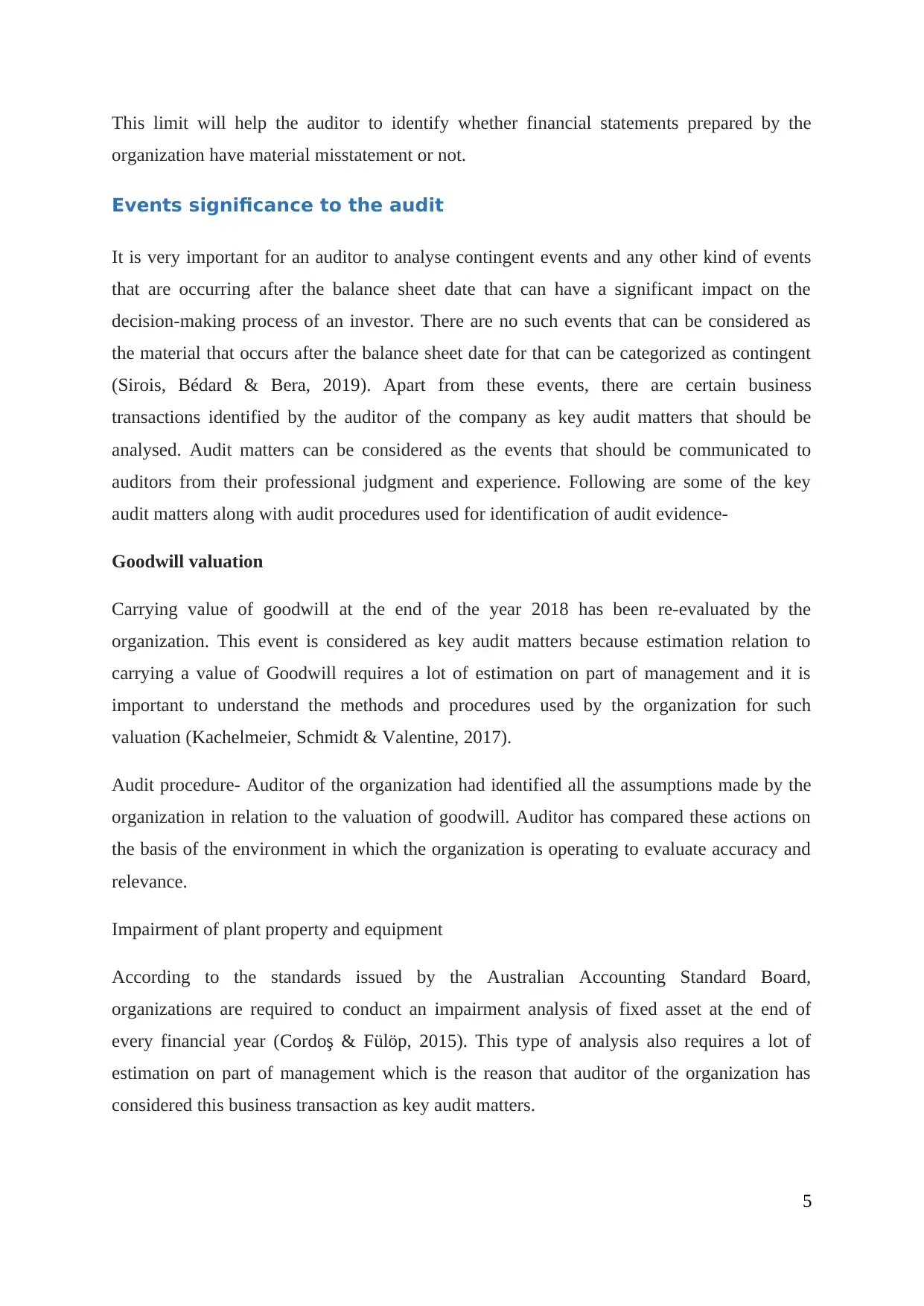
This limit will help the auditor to identify whether financial statements prepared by the
organization have material misstatement or not.
Events significance to the audit
It is very important for an auditor to analyse contingent events and any other kind of events
that are occurring after the balance sheet date that can have a significant impact on the
decision-making process of an investor. There are no such events that can be considered as
the material that occurs after the balance sheet date for that can be categorized as contingent
(Sirois, Bédard & Bera, 2019). Apart from these events, there are certain business
transactions identified by the auditor of the company as key audit matters that should be
analysed. Audit matters can be considered as the events that should be communicated to
auditors from their professional judgment and experience. Following are some of the key
audit matters along with audit procedures used for identification of audit evidence-
Goodwill valuation
Carrying value of goodwill at the end of the year 2018 has been re-evaluated by the
organization. This event is considered as key audit matters because estimation relation to
carrying a value of Goodwill requires a lot of estimation on part of management and it is
important to understand the methods and procedures used by the organization for such
valuation (Kachelmeier, Schmidt & Valentine, 2017).
Audit procedure- Auditor of the organization had identified all the assumptions made by the
organization in relation to the valuation of goodwill. Auditor has compared these actions on
the basis of the environment in which the organization is operating to evaluate accuracy and
relevance.
Impairment of plant property and equipment
According to the standards issued by the Australian Accounting Standard Board,
organizations are required to conduct an impairment analysis of fixed asset at the end of
every financial year (Cordoş & Fülöp, 2015). This type of analysis also requires a lot of
estimation on part of management which is the reason that auditor of the organization has
considered this business transaction as key audit matters.
5
organization have material misstatement or not.
Events significance to the audit
It is very important for an auditor to analyse contingent events and any other kind of events
that are occurring after the balance sheet date that can have a significant impact on the
decision-making process of an investor. There are no such events that can be considered as
the material that occurs after the balance sheet date for that can be categorized as contingent
(Sirois, Bédard & Bera, 2019). Apart from these events, there are certain business
transactions identified by the auditor of the company as key audit matters that should be
analysed. Audit matters can be considered as the events that should be communicated to
auditors from their professional judgment and experience. Following are some of the key
audit matters along with audit procedures used for identification of audit evidence-
Goodwill valuation
Carrying value of goodwill at the end of the year 2018 has been re-evaluated by the
organization. This event is considered as key audit matters because estimation relation to
carrying a value of Goodwill requires a lot of estimation on part of management and it is
important to understand the methods and procedures used by the organization for such
valuation (Kachelmeier, Schmidt & Valentine, 2017).
Audit procedure- Auditor of the organization had identified all the assumptions made by the
organization in relation to the valuation of goodwill. Auditor has compared these actions on
the basis of the environment in which the organization is operating to evaluate accuracy and
relevance.
Impairment of plant property and equipment
According to the standards issued by the Australian Accounting Standard Board,
organizations are required to conduct an impairment analysis of fixed asset at the end of
every financial year (Cordoş & Fülöp, 2015). This type of analysis also requires a lot of
estimation on part of management which is the reason that auditor of the organization has
considered this business transaction as key audit matters.
5
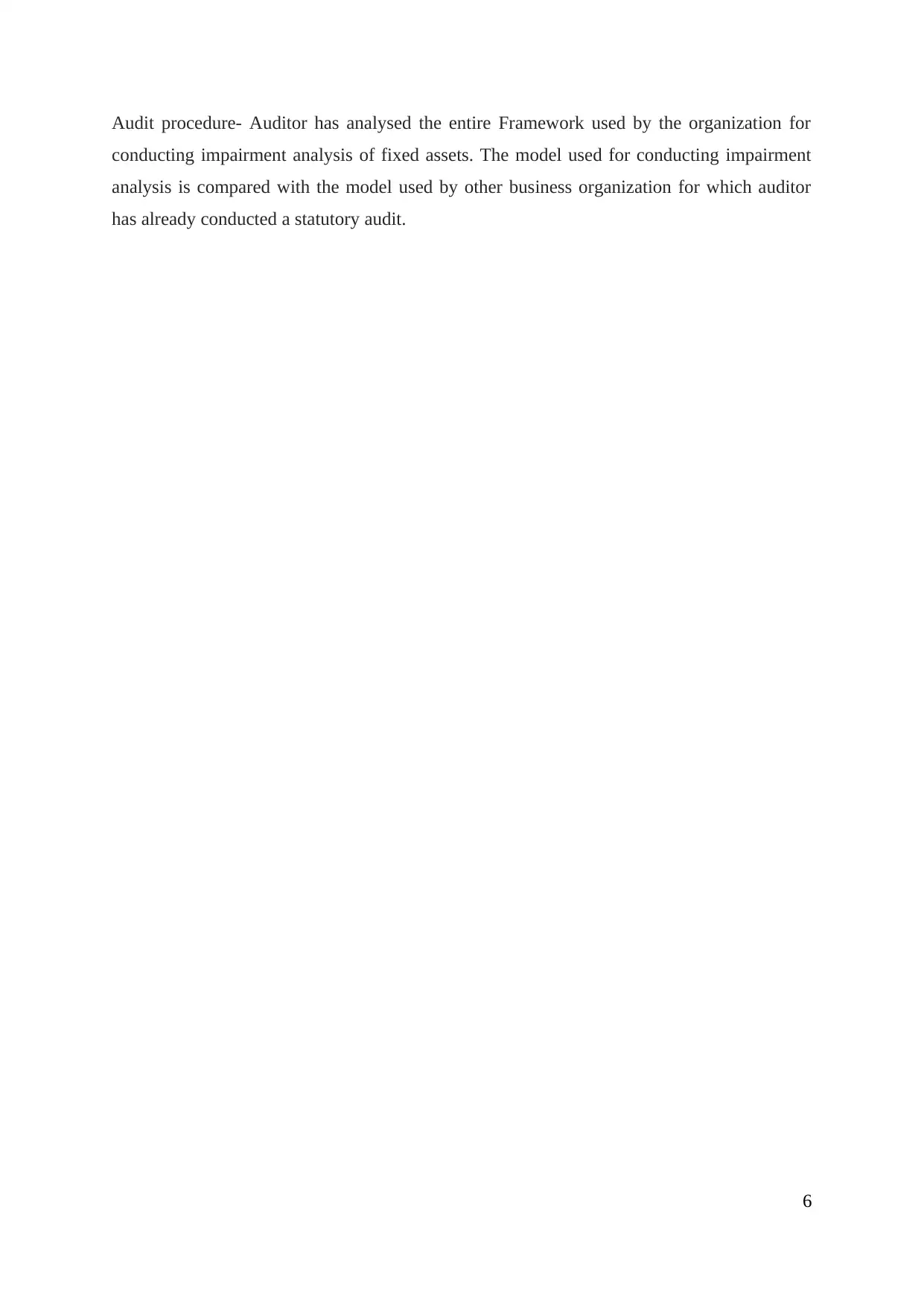
Audit procedure- Auditor has analysed the entire Framework used by the organization for
conducting impairment analysis of fixed assets. The model used for conducting impairment
analysis is compared with the model used by other business organization for which auditor
has already conducted a statutory audit.
6
conducting impairment analysis of fixed assets. The model used for conducting impairment
analysis is compared with the model used by other business organization for which auditor
has already conducted a statutory audit.
6
⊘ This is a preview!⊘
Do you want full access?
Subscribe today to unlock all pages.

Trusted by 1+ million students worldwide
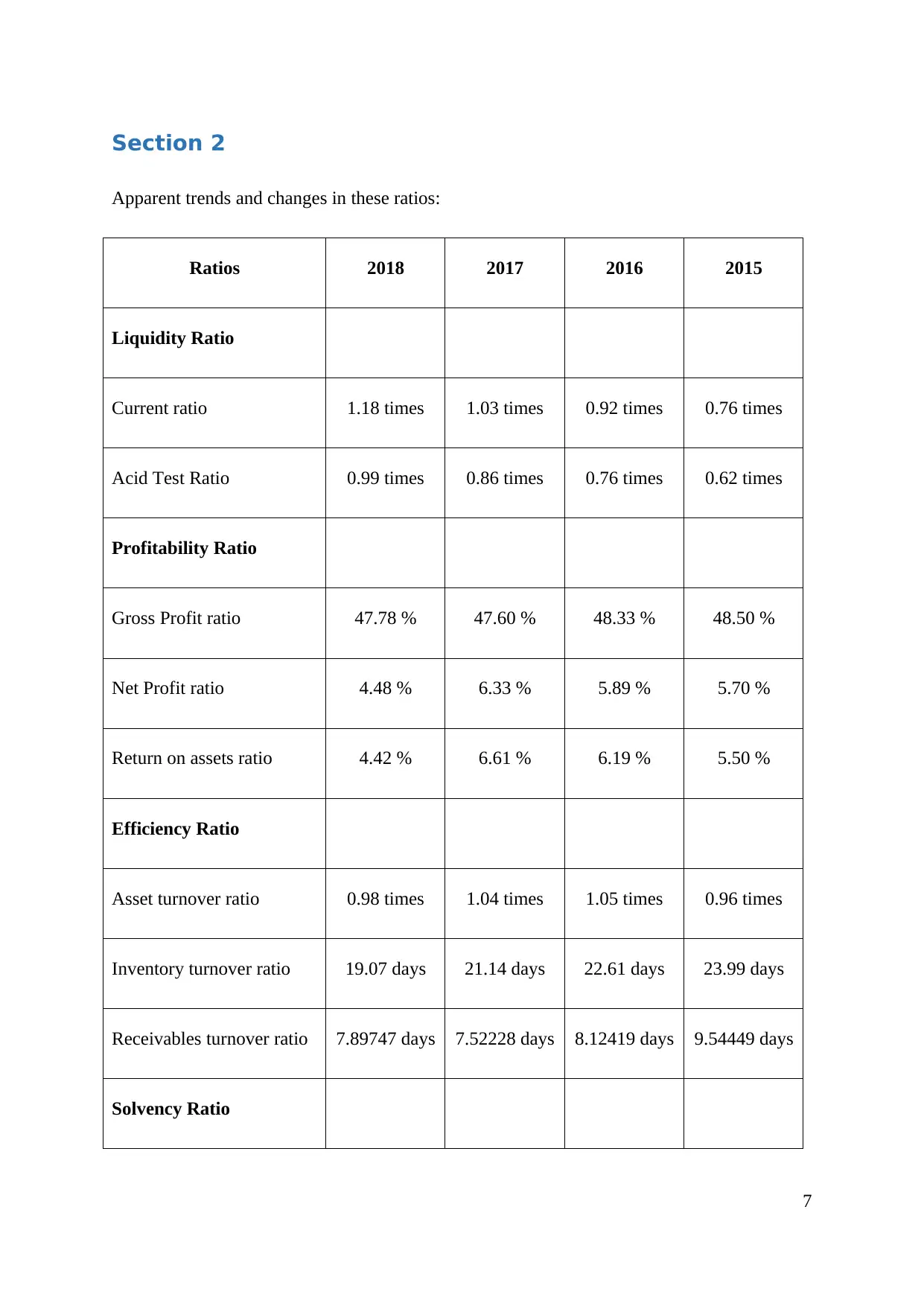
Section 2
Apparent trends and changes in these ratios:
Ratios 2018 2017 2016 2015
Liquidity Ratio
Current ratio 1.18 times 1.03 times 0.92 times 0.76 times
Acid Test Ratio 0.99 times 0.86 times 0.76 times 0.62 times
Profitability Ratio
Gross Profit ratio 47.78 % 47.60 % 48.33 % 48.50 %
Net Profit ratio 4.48 % 6.33 % 5.89 % 5.70 %
Return on assets ratio 4.42 % 6.61 % 6.19 % 5.50 %
Efficiency Ratio
Asset turnover ratio 0.98 times 1.04 times 1.05 times 0.96 times
Inventory turnover ratio 19.07 days 21.14 days 22.61 days 23.99 days
Receivables turnover ratio 7.89747 days 7.52228 days 8.12419 days 9.54449 days
Solvency Ratio
7
Apparent trends and changes in these ratios:
Ratios 2018 2017 2016 2015
Liquidity Ratio
Current ratio 1.18 times 1.03 times 0.92 times 0.76 times
Acid Test Ratio 0.99 times 0.86 times 0.76 times 0.62 times
Profitability Ratio
Gross Profit ratio 47.78 % 47.60 % 48.33 % 48.50 %
Net Profit ratio 4.48 % 6.33 % 5.89 % 5.70 %
Return on assets ratio 4.42 % 6.61 % 6.19 % 5.50 %
Efficiency Ratio
Asset turnover ratio 0.98 times 1.04 times 1.05 times 0.96 times
Inventory turnover ratio 19.07 days 21.14 days 22.61 days 23.99 days
Receivables turnover ratio 7.89747 days 7.52228 days 8.12419 days 9.54449 days
Solvency Ratio
7
Paraphrase This Document
Need a fresh take? Get an instant paraphrase of this document with our AI Paraphraser
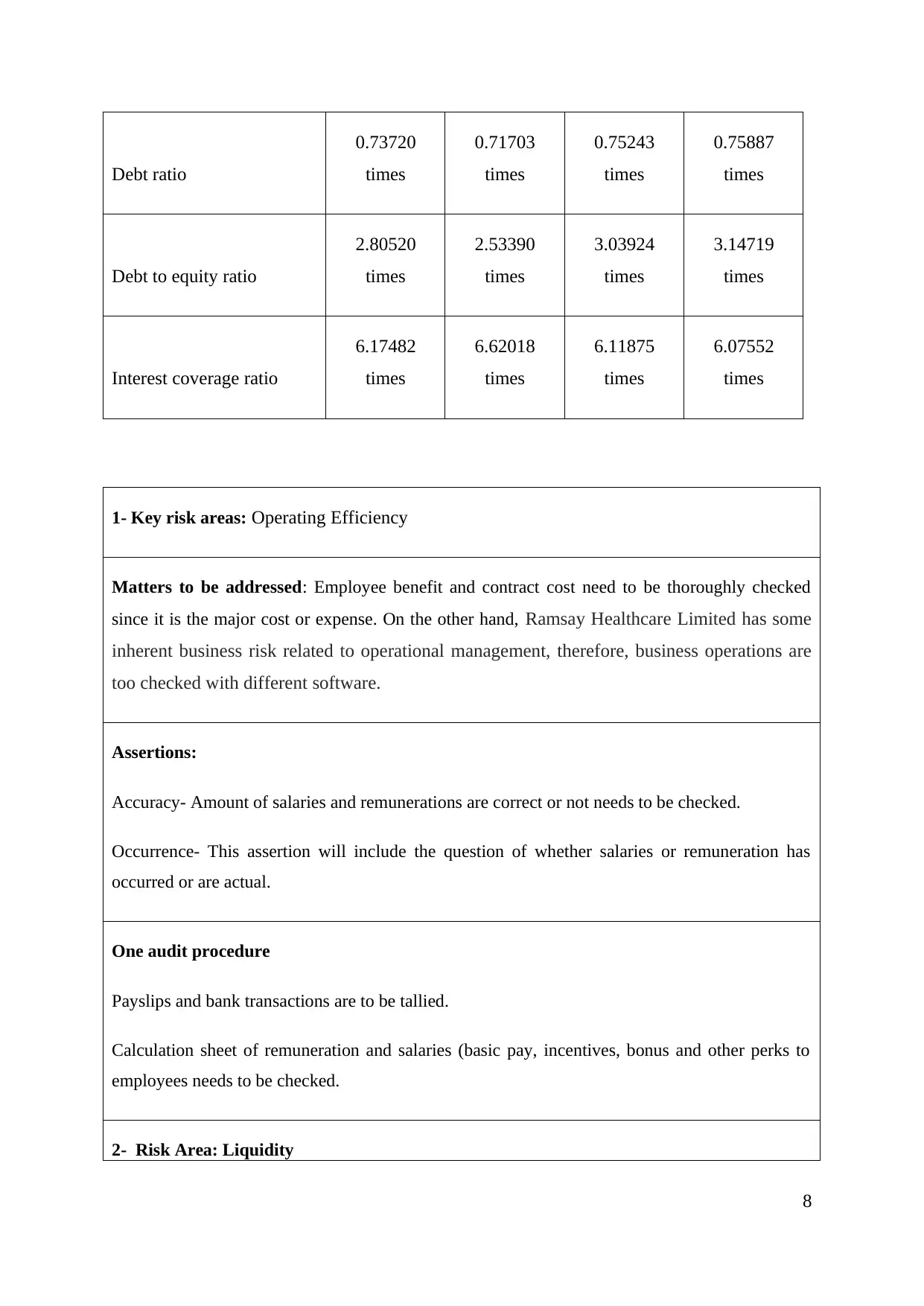
Debt ratio
0.73720
times
0.71703
times
0.75243
times
0.75887
times
Debt to equity ratio
2.80520
times
2.53390
times
3.03924
times
3.14719
times
Interest coverage ratio
6.17482
times
6.62018
times
6.11875
times
6.07552
times
1- Key risk areas: Operating Efficiency
Matters to be addressed: Employee benefit and contract cost need to be thoroughly checked
since it is the major cost or expense. On the other hand, Ramsay Healthcare Limited has some
inherent business risk related to operational management, therefore, business operations are
too checked with different software.
Assertions:
Accuracy- Amount of salaries and remunerations are correct or not needs to be checked.
Occurrence- This assertion will include the question of whether salaries or remuneration has
occurred or are actual.
One audit procedure
Payslips and bank transactions are to be tallied.
Calculation sheet of remuneration and salaries (basic pay, incentives, bonus and other perks to
employees needs to be checked.
2- Risk Area: Liquidity
8
0.73720
times
0.71703
times
0.75243
times
0.75887
times
Debt to equity ratio
2.80520
times
2.53390
times
3.03924
times
3.14719
times
Interest coverage ratio
6.17482
times
6.62018
times
6.11875
times
6.07552
times
1- Key risk areas: Operating Efficiency
Matters to be addressed: Employee benefit and contract cost need to be thoroughly checked
since it is the major cost or expense. On the other hand, Ramsay Healthcare Limited has some
inherent business risk related to operational management, therefore, business operations are
too checked with different software.
Assertions:
Accuracy- Amount of salaries and remunerations are correct or not needs to be checked.
Occurrence- This assertion will include the question of whether salaries or remuneration has
occurred or are actual.
One audit procedure
Payslips and bank transactions are to be tallied.
Calculation sheet of remuneration and salaries (basic pay, incentives, bonus and other perks to
employees needs to be checked.
2- Risk Area: Liquidity
8
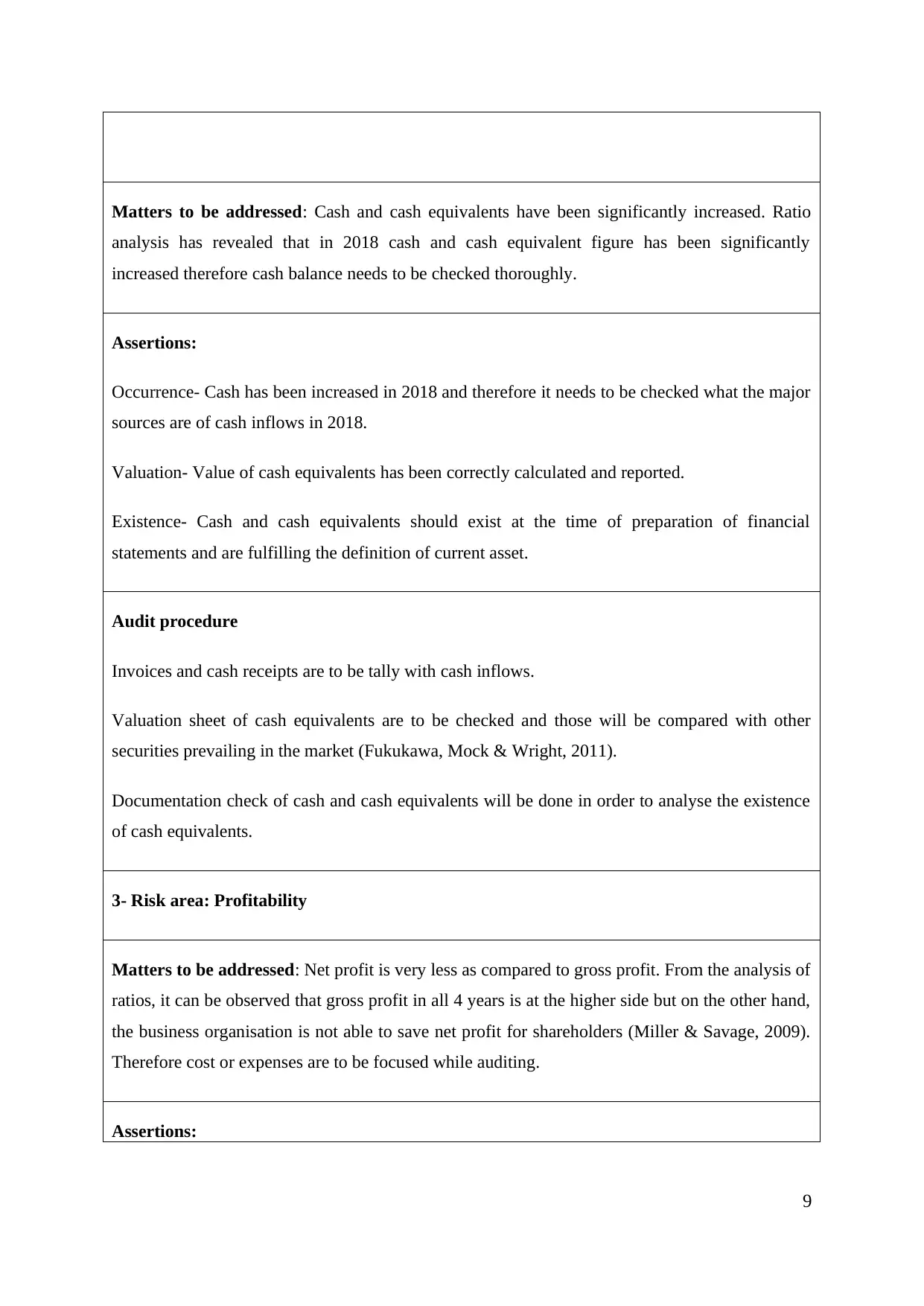
Matters to be addressed: Cash and cash equivalents have been significantly increased. Ratio
analysis has revealed that in 2018 cash and cash equivalent figure has been significantly
increased therefore cash balance needs to be checked thoroughly.
Assertions:
Occurrence- Cash has been increased in 2018 and therefore it needs to be checked what the major
sources are of cash inflows in 2018.
Valuation- Value of cash equivalents has been correctly calculated and reported.
Existence- Cash and cash equivalents should exist at the time of preparation of financial
statements and are fulfilling the definition of current asset.
Audit procedure
Invoices and cash receipts are to be tally with cash inflows.
Valuation sheet of cash equivalents are to be checked and those will be compared with other
securities prevailing in the market (Fukukawa, Mock & Wright, 2011).
Documentation check of cash and cash equivalents will be done in order to analyse the existence
of cash equivalents.
3- Risk area: Profitability
Matters to be addressed: Net profit is very less as compared to gross profit. From the analysis of
ratios, it can be observed that gross profit in all 4 years is at the higher side but on the other hand,
the business organisation is not able to save net profit for shareholders (Miller & Savage, 2009).
Therefore cost or expenses are to be focused while auditing.
Assertions:
9
analysis has revealed that in 2018 cash and cash equivalent figure has been significantly
increased therefore cash balance needs to be checked thoroughly.
Assertions:
Occurrence- Cash has been increased in 2018 and therefore it needs to be checked what the major
sources are of cash inflows in 2018.
Valuation- Value of cash equivalents has been correctly calculated and reported.
Existence- Cash and cash equivalents should exist at the time of preparation of financial
statements and are fulfilling the definition of current asset.
Audit procedure
Invoices and cash receipts are to be tally with cash inflows.
Valuation sheet of cash equivalents are to be checked and those will be compared with other
securities prevailing in the market (Fukukawa, Mock & Wright, 2011).
Documentation check of cash and cash equivalents will be done in order to analyse the existence
of cash equivalents.
3- Risk area: Profitability
Matters to be addressed: Net profit is very less as compared to gross profit. From the analysis of
ratios, it can be observed that gross profit in all 4 years is at the higher side but on the other hand,
the business organisation is not able to save net profit for shareholders (Miller & Savage, 2009).
Therefore cost or expenses are to be focused while auditing.
Assertions:
9
⊘ This is a preview!⊘
Do you want full access?
Subscribe today to unlock all pages.

Trusted by 1+ million students worldwide
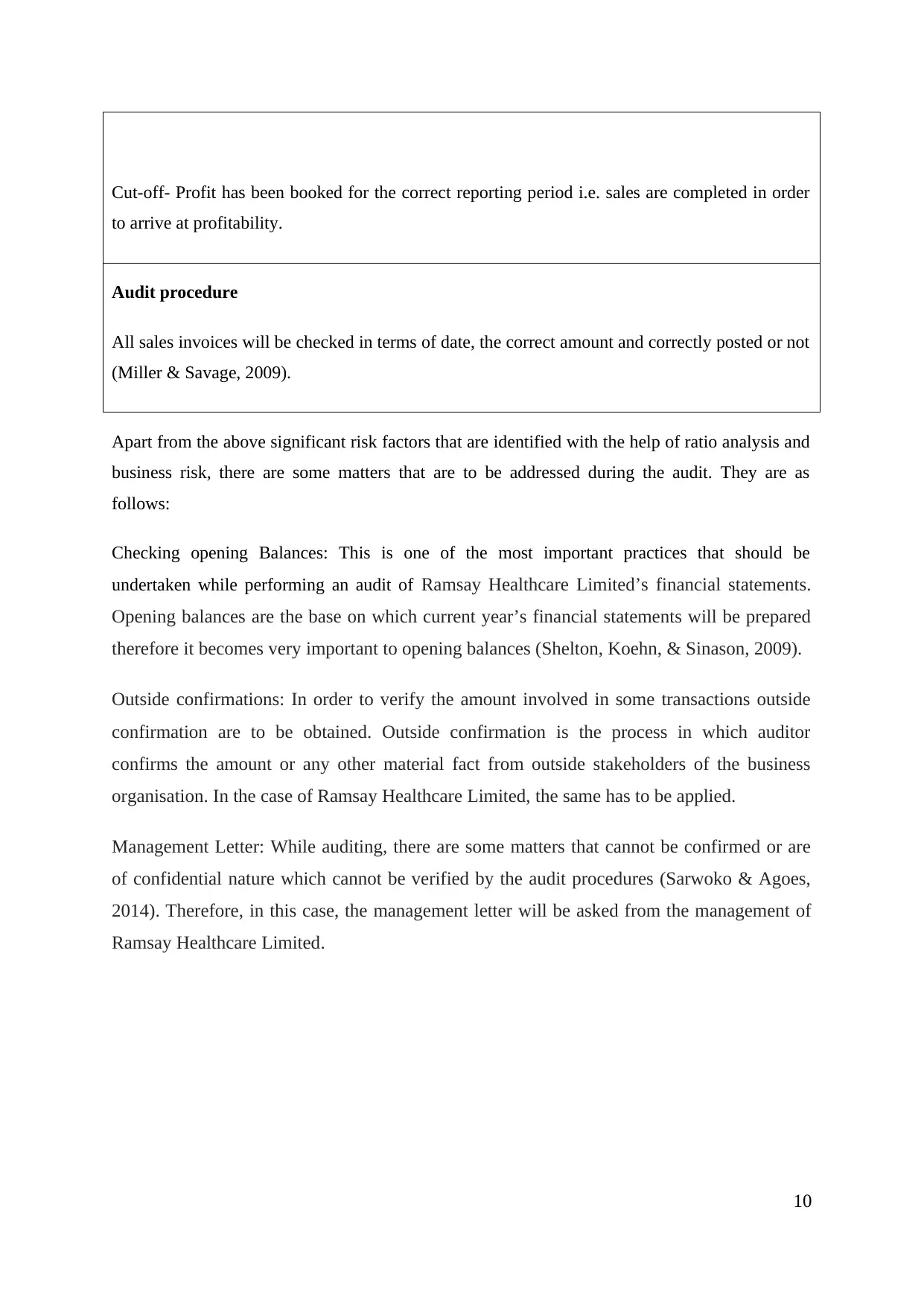
Cut-off- Profit has been booked for the correct reporting period i.e. sales are completed in order
to arrive at profitability.
Audit procedure
All sales invoices will be checked in terms of date, the correct amount and correctly posted or not
(Miller & Savage, 2009).
Apart from the above significant risk factors that are identified with the help of ratio analysis and
business risk, there are some matters that are to be addressed during the audit. They are as
follows:
Checking opening Balances: This is one of the most important practices that should be
undertaken while performing an audit of Ramsay Healthcare Limited’s financial statements.
Opening balances are the base on which current year’s financial statements will be prepared
therefore it becomes very important to opening balances (Shelton, Koehn, & Sinason, 2009).
Outside confirmations: In order to verify the amount involved in some transactions outside
confirmation are to be obtained. Outside confirmation is the process in which auditor
confirms the amount or any other material fact from outside stakeholders of the business
organisation. In the case of Ramsay Healthcare Limited, the same has to be applied.
Management Letter: While auditing, there are some matters that cannot be confirmed or are
of confidential nature which cannot be verified by the audit procedures (Sarwoko & Agoes,
2014). Therefore, in this case, the management letter will be asked from the management of
Ramsay Healthcare Limited.
10
to arrive at profitability.
Audit procedure
All sales invoices will be checked in terms of date, the correct amount and correctly posted or not
(Miller & Savage, 2009).
Apart from the above significant risk factors that are identified with the help of ratio analysis and
business risk, there are some matters that are to be addressed during the audit. They are as
follows:
Checking opening Balances: This is one of the most important practices that should be
undertaken while performing an audit of Ramsay Healthcare Limited’s financial statements.
Opening balances are the base on which current year’s financial statements will be prepared
therefore it becomes very important to opening balances (Shelton, Koehn, & Sinason, 2009).
Outside confirmations: In order to verify the amount involved in some transactions outside
confirmation are to be obtained. Outside confirmation is the process in which auditor
confirms the amount or any other material fact from outside stakeholders of the business
organisation. In the case of Ramsay Healthcare Limited, the same has to be applied.
Management Letter: While auditing, there are some matters that cannot be confirmed or are
of confidential nature which cannot be verified by the audit procedures (Sarwoko & Agoes,
2014). Therefore, in this case, the management letter will be asked from the management of
Ramsay Healthcare Limited.
10
Paraphrase This Document
Need a fresh take? Get an instant paraphrase of this document with our AI Paraphraser
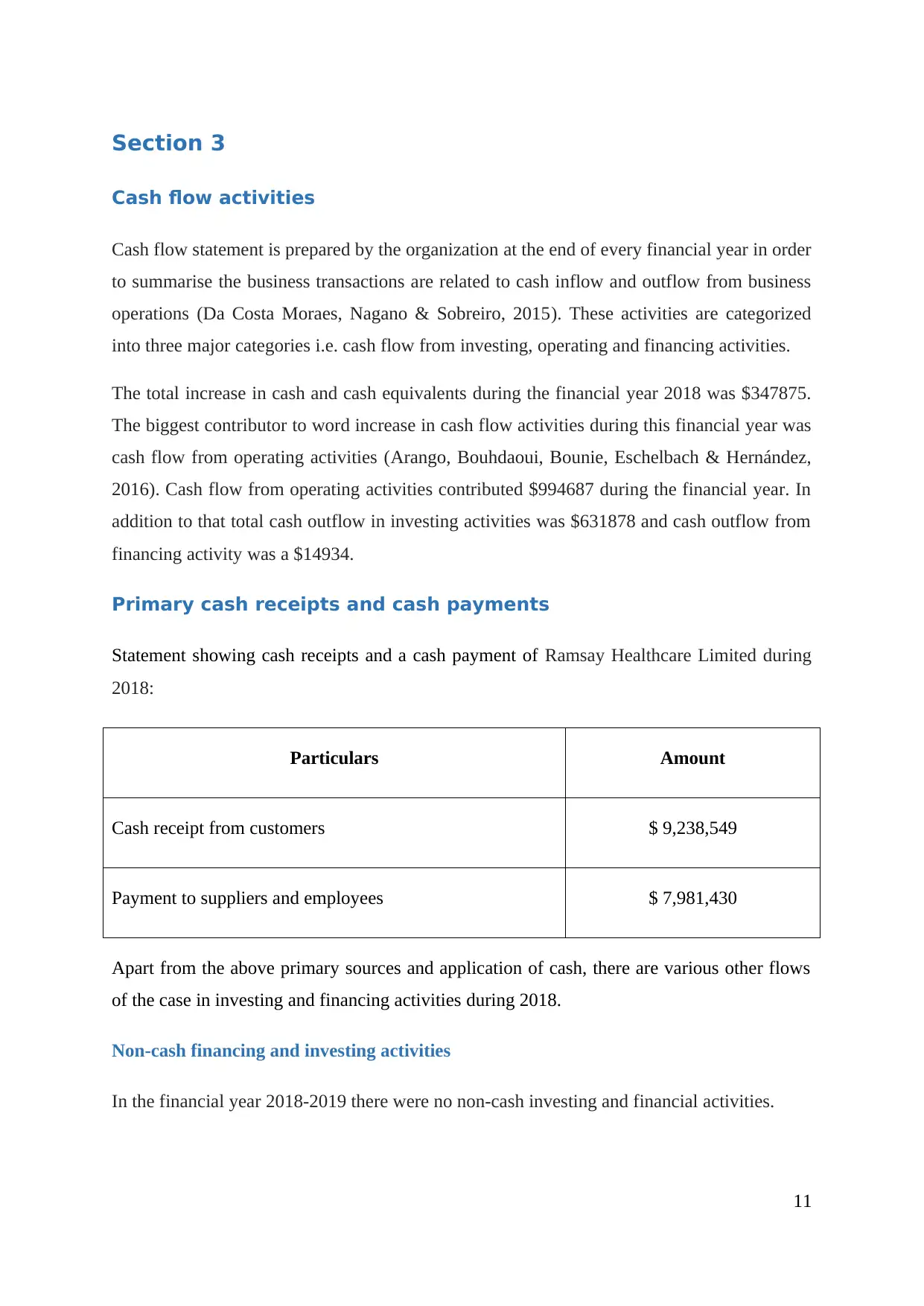
Section 3
Cash flow activities
Cash flow statement is prepared by the organization at the end of every financial year in order
to summarise the business transactions are related to cash inflow and outflow from business
operations (Da Costa Moraes, Nagano & Sobreiro, 2015). These activities are categorized
into three major categories i.e. cash flow from investing, operating and financing activities.
The total increase in cash and cash equivalents during the financial year 2018 was $347875.
The biggest contributor to word increase in cash flow activities during this financial year was
cash flow from operating activities (Arango, Bouhdaoui, Bounie, Eschelbach & Hernández,
2016). Cash flow from operating activities contributed $994687 during the financial year. In
addition to that total cash outflow in investing activities was $631878 and cash outflow from
financing activity was a $14934.
Primary cash receipts and cash payments
Statement showing cash receipts and a cash payment of Ramsay Healthcare Limited during
2018:
Particulars Amount
Cash receipt from customers $ 9,238,549
Payment to suppliers and employees $ 7,981,430
Apart from the above primary sources and application of cash, there are various other flows
of the case in investing and financing activities during 2018.
Non-cash financing and investing activities
In the financial year 2018-2019 there were no non-cash investing and financial activities.
11
Cash flow activities
Cash flow statement is prepared by the organization at the end of every financial year in order
to summarise the business transactions are related to cash inflow and outflow from business
operations (Da Costa Moraes, Nagano & Sobreiro, 2015). These activities are categorized
into three major categories i.e. cash flow from investing, operating and financing activities.
The total increase in cash and cash equivalents during the financial year 2018 was $347875.
The biggest contributor to word increase in cash flow activities during this financial year was
cash flow from operating activities (Arango, Bouhdaoui, Bounie, Eschelbach & Hernández,
2016). Cash flow from operating activities contributed $994687 during the financial year. In
addition to that total cash outflow in investing activities was $631878 and cash outflow from
financing activity was a $14934.
Primary cash receipts and cash payments
Statement showing cash receipts and a cash payment of Ramsay Healthcare Limited during
2018:
Particulars Amount
Cash receipt from customers $ 9,238,549
Payment to suppliers and employees $ 7,981,430
Apart from the above primary sources and application of cash, there are various other flows
of the case in investing and financing activities during 2018.
Non-cash financing and investing activities
In the financial year 2018-2019 there were no non-cash investing and financial activities.
11
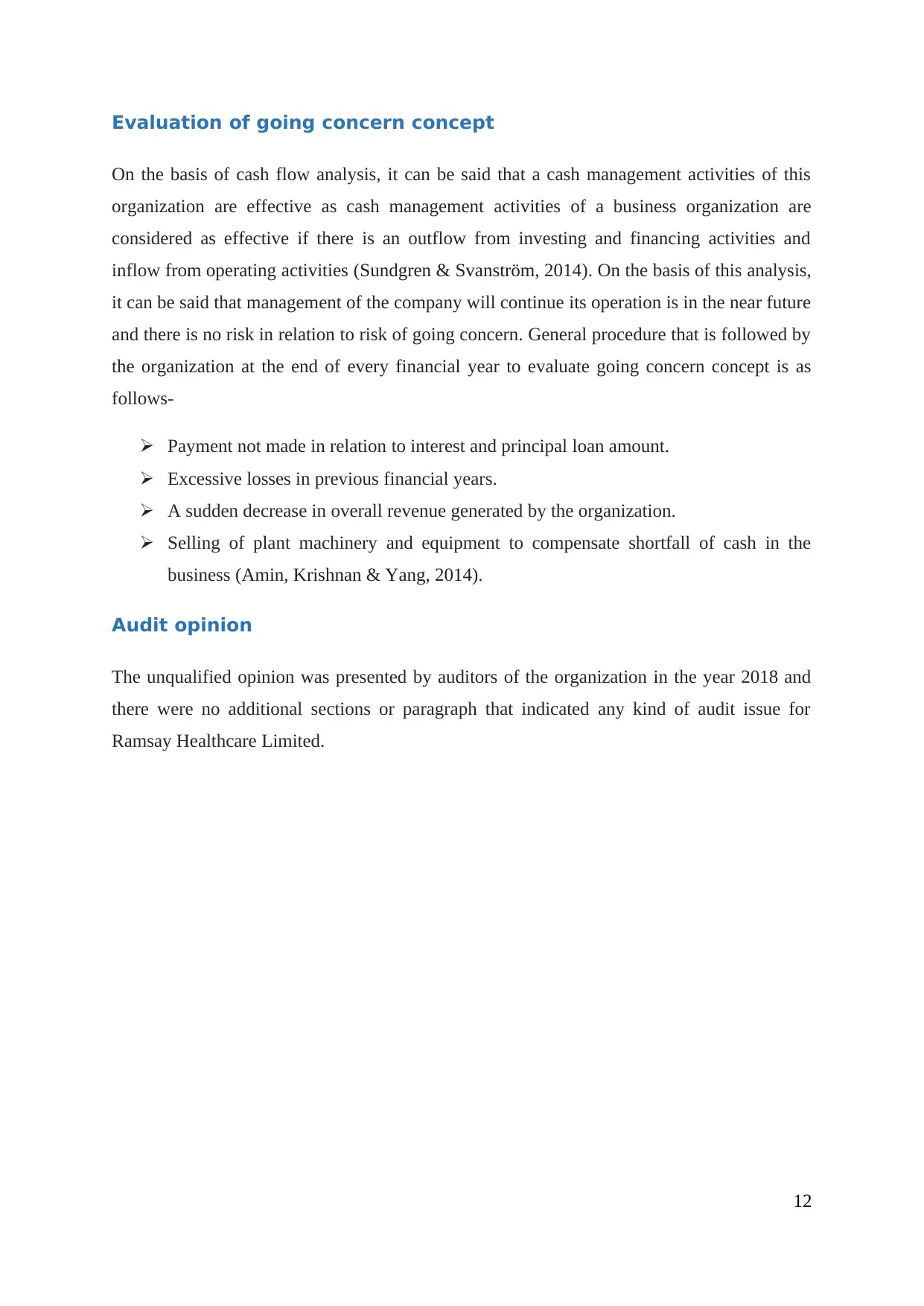
Evaluation of going concern concept
On the basis of cash flow analysis, it can be said that a cash management activities of this
organization are effective as cash management activities of a business organization are
considered as effective if there is an outflow from investing and financing activities and
inflow from operating activities (Sundgren & Svanström, 2014). On the basis of this analysis,
it can be said that management of the company will continue its operation is in the near future
and there is no risk in relation to risk of going concern. General procedure that is followed by
the organization at the end of every financial year to evaluate going concern concept is as
follows-
Payment not made in relation to interest and principal loan amount.
Excessive losses in previous financial years.
A sudden decrease in overall revenue generated by the organization.
Selling of plant machinery and equipment to compensate shortfall of cash in the
business (Amin, Krishnan & Yang, 2014).
Audit opinion
The unqualified opinion was presented by auditors of the organization in the year 2018 and
there were no additional sections or paragraph that indicated any kind of audit issue for
Ramsay Healthcare Limited.
12
On the basis of cash flow analysis, it can be said that a cash management activities of this
organization are effective as cash management activities of a business organization are
considered as effective if there is an outflow from investing and financing activities and
inflow from operating activities (Sundgren & Svanström, 2014). On the basis of this analysis,
it can be said that management of the company will continue its operation is in the near future
and there is no risk in relation to risk of going concern. General procedure that is followed by
the organization at the end of every financial year to evaluate going concern concept is as
follows-
Payment not made in relation to interest and principal loan amount.
Excessive losses in previous financial years.
A sudden decrease in overall revenue generated by the organization.
Selling of plant machinery and equipment to compensate shortfall of cash in the
business (Amin, Krishnan & Yang, 2014).
Audit opinion
The unqualified opinion was presented by auditors of the organization in the year 2018 and
there were no additional sections or paragraph that indicated any kind of audit issue for
Ramsay Healthcare Limited.
12
⊘ This is a preview!⊘
Do you want full access?
Subscribe today to unlock all pages.

Trusted by 1+ million students worldwide
1 out of 16
Related Documents
Your All-in-One AI-Powered Toolkit for Academic Success.
+13062052269
info@desklib.com
Available 24*7 on WhatsApp / Email
![[object Object]](/_next/static/media/star-bottom.7253800d.svg)
Unlock your academic potential
Copyright © 2020–2025 A2Z Services. All Rights Reserved. Developed and managed by ZUCOL.





